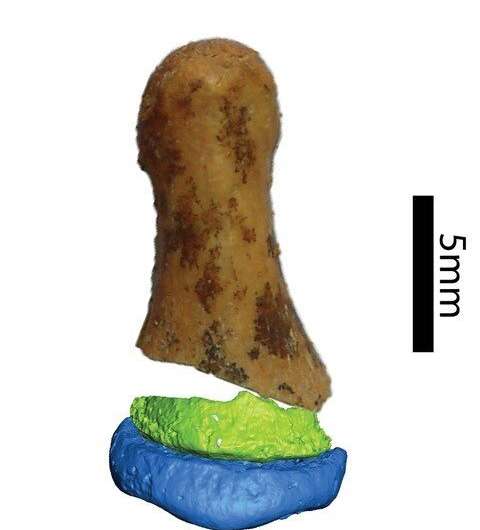Virtual reconstruction of fifth distal phalanx from Denisova Cave. Credit: © Photo of distal fragment of phalanx: Eva-Maria Geigl, Institut Jacques Monod (CNRS / Université de Paris). Micro-CT scan and virtual reconstruction: Bence Viola, Department of Anthropology, University of Toronto (Canada).
A team of researchers with members from France, Canada and Russia has found evidence that shows Denisovan hominins had fingers that more closely resemble modern humans than Neanderthals. In their paper published in the journal Science Advances, they describe their analysis of a finger fossil found back in 2008 and what it showed.
Prior research has shown that approximately 800,000 years ago, Neanderthals and modern humans diverged from some unknown common ancestor. Then approximately 400,000 years ago, another split occurred—a group that led to the Denisovans diverging from Neanderthals. After the split, the group that became the Denisovans moved into Asia, while Neanderthals remained mostly in Europe. Each of the three groups evolved unique characteristics, but they remained similar enough to interbreed on occasion. Interestingly, study of modern human DNA has found evidence of a split within the Denisovans as well, in later years.
The existence of the Denisovans was not known until 2010, when a bit of a pinky finger, found two years earlier in what is now known as Denisova Cave, was identified as belonging to a new kind of hominin. Since that time, just a few other Denisovan fossils have been found—a jaw bone, three molars and a fingertip. In this new effort, the researchers carefully studied the fingertip and found that it was part of the same pinky finger as the other fragment. And together, they provided a sample of what the Denisovan fingers looked like.
The researchers report that the Denisovan fingers were remarkably similar to those of modern humans—and not much like Neanderthals. The find was surprising, given that Denisovan and Neanderthal are far more closely related. The researchers are quick to note that the finding does not suggest that Denisovans looked more like modern humans in general; there is no evidence for that (indeed, the jawbone fossil was not very close to the modern human jawbone). But it does suggest that the Denisovans used their hands as they evolved in ways similar to that of modern humans. The researchers say that other researchers should be careful to avoid accidentally labeling Denisovan fossils as modern human, just in case there are other similarities.
More information: E. Andrew Bennett et al. Morphology of the Denisovan phalanx closer to modern humans than to Neanderthals, Science Advances (2019). DOI: 10.1126/sciadv.aaw3950
Journal information: Science Advances
© 2019 Science X Network
























